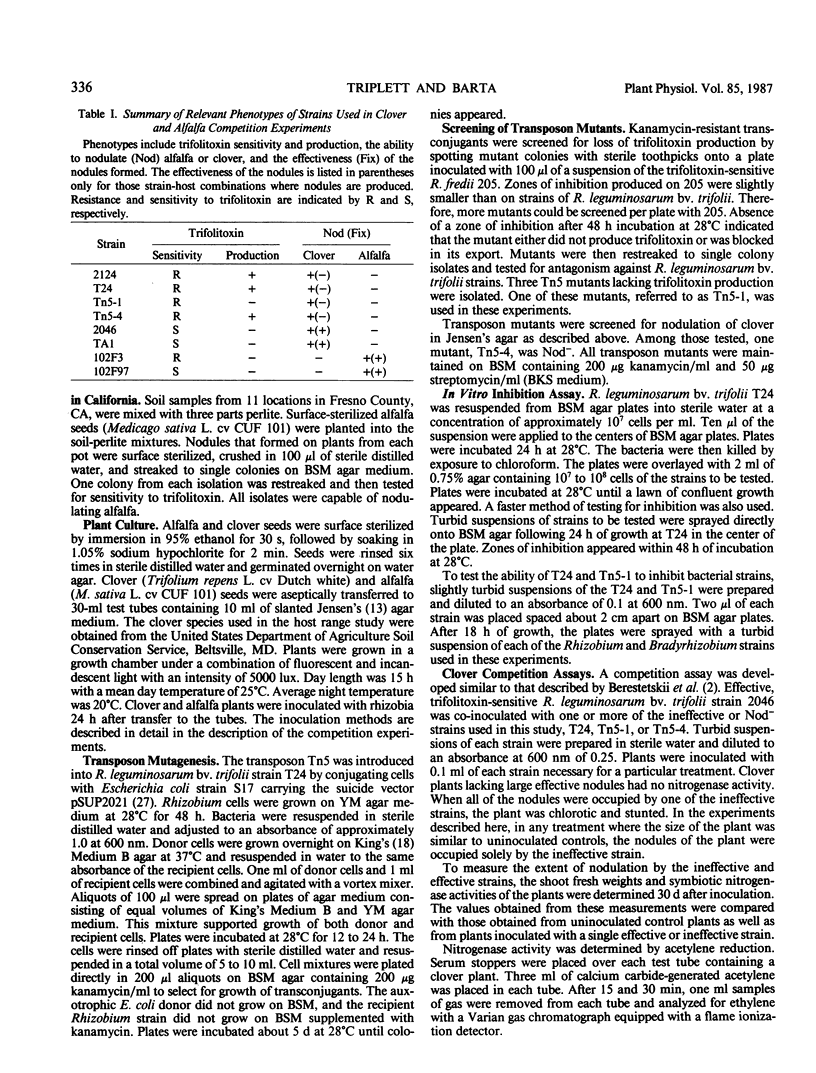Abstract
Rhizobium leguminosarum bv. trifolii T24 is ineffective in symbiotic nitrogen fixation, produces a potent antibiotic (referred to here as trifolitoxin) that is bacteriostatic to certain Rhizobium strains, and is very competitive for clover root nodulation (EA Schwinghamer, RP Belkengren 1968 Arch Mikrobiol 64: 130-145). The primary objective of this work was to demonstrate the roles of nodulation and trifolitoxin production in the expression of nodulation competitiveness by T24. Unlike wildtype T24, transposon mutants of T24 lacking trifolitoxin production were unable to decrease clover nodulation by an effective, trifolitoxin-sensitive strain of R. leguminosarum bv. trifolii. A non-nodulating transposon mutant of T24 prevented clover nodulation by a trifolitoxin-sensitive R. leguminosarum bv. trifolii when co-inoculated with a T24 mutant lacking trifolitoxin production. Neither mutant alone prevented nodulation by the trifolitoxin-sensitive strain. These results demonstrate that trifolitoxin production and nodulation are required for the expression of nodulation competitiveness by strain T24. A trifolitoxin-sensitive strain of R. meliloti did not nodulate alfalfa when co-inoculated with T24 and a trifolitoxin-resistant strain of R. meliloti. Thus, a trifolitoxin-producing strain was useful in regulating nodule occupancy on a legume host other than clover. Trifolitoxin production was constitutive in both minimal and enriched media. Trifolitoxin was found to inhibit the growth of 95% of all strains of R. leguminosarum bvs. trifolii, viceae, and phaseoli tested. Strains of all 13 biotypes of R. leguminosarum bv. trifolii were inhibited by trifolitoxin. Three strains of R. fredii were also inhibited. Strain T24 ineffectively nodulated 46 clover species, did not nodulate Trifolium ambiguum, and induced partially effective nodules on Trifolium micranthum. Since T24 produced partially effective nodules on T. micranthum and since a trifolitoxin-minus mutant of T24 induced ineffective nodules, trifolitoxin production is not the cause of the symbiotic ineffectiveness of T24.
Full text
PDF







Selected References
These references are in PubMed. This may not be the complete list of references from this article.
- Bender C. L., Cooksey D. A. Indigenous plasmids in Pseudomonas syringae pv. tomato: conjugative transfer and role in copper resistance. J Bacteriol. 1986 Feb;165(2):534–541. doi: 10.1128/jb.165.2.534-541.1986. [DOI] [PMC free article] [PubMed] [Google Scholar]
- Dowling D. N., Broughton W. J. Competition for nodulation of legumes. Annu Rev Microbiol. 1986;40:131–157. doi: 10.1146/annurev.mi.40.100186.001023. [DOI] [PubMed] [Google Scholar]
- Dowling D. N., Samrey U., Stanley J., Broughton W. J. Cloning of Rhizobium leguminosarum genes for competitive nodulation blocking on peas. J Bacteriol. 1987 Mar;169(3):1345–1348. doi: 10.1128/jb.169.3.1345-1348.1987. [DOI] [PMC free article] [PubMed] [Google Scholar]
- Gibbins A. M., Gregory K. F. Relatedness among Rhizobium and Agrobacterium species determined by three methods of nucleic acid hybridization. J Bacteriol. 1972 Jul;111(1):129–141. doi: 10.1128/jb.111.1.129-141.1972. [DOI] [PMC free article] [PubMed] [Google Scholar]
- Joseph M. V., Desai J. D., Desai A. J. Possible Involvement of Phage-Like Structures in Antagonism of Cowpea Rhizobia by Rhizobium trifolii. Appl Environ Microbiol. 1985 Feb;49(2):459–461. doi: 10.1128/aem.49.2.459-461.1985. [DOI] [PMC free article] [PubMed] [Google Scholar]
- Joseph M. V., Desai J. D., Desai A. J. Production of Antimicrobial and Bacteriocin-Like Substances by Rhizobium trifolii. Appl Environ Microbiol. 1983 Feb;45(2):532–535. doi: 10.1128/aem.45.2.532-535.1983. [DOI] [PMC free article] [PubMed] [Google Scholar]
- KING E. O., WARD M. K., RANEY D. E. Two simple media for the demonstration of pyocyanin and fluorescin. J Lab Clin Med. 1954 Aug;44(2):301–307. [PubMed] [Google Scholar]
- Kosslak R. M., Bohlool B. B. Influence of Environmental Factors on Interstrain Competition in Rhizobium japonicum. Appl Environ Microbiol. 1985 May;49(5):1128–1133. doi: 10.1128/aem.49.5.1128-1133.1985. [DOI] [PMC free article] [PubMed] [Google Scholar]
- McLoughlin T. J., Merlo A. O., Satola S. W., Johansen E. Isolation of competition-defective mutants of Rhizobium fredii. J Bacteriol. 1987 Jan;169(1):410–413. doi: 10.1128/jb.169.1.410-413.1987. [DOI] [PMC free article] [PubMed] [Google Scholar]
- Schwinghamer E. A., Belkengren R. P. Inhibition of rhizobia by a strain of Rhizobeium trifolii: some properties of the antibiotic and of the strain. Arch Mikrobiol. 1968;64(2):130–145. doi: 10.1007/BF00406972. [DOI] [PubMed] [Google Scholar]
- Schwinghamer E. A., Pankhurst C. E., Whitfeld P. R. A phage-like bacteriocin of Rhizobium trifolii. Can J Microbiol. 1973 Mar;19(3):359–368. doi: 10.1139/m73-059. [DOI] [PubMed] [Google Scholar]
- Schwinghamer E. A. Properties of some bacteriocins produced by Rhizobium trifolii. J Gen Microbiol. 1975 Dec;91(2):403–413. doi: 10.1099/00221287-91-2-403. [DOI] [PubMed] [Google Scholar]


